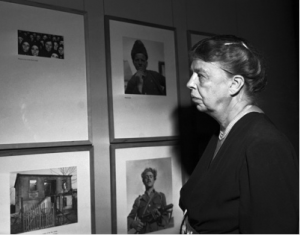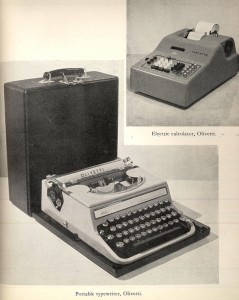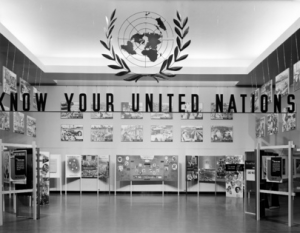Press Releases from World War II and beyond
The previous post on the Museum’s recently completed digitizing of historical exhibition press releases highlighted some excerpts from the 1920s, 30s, and early 40s. There are many interesting releases from World War II and its aftermath—so many, in fact, that it was tough to choose which to include here. Hopefully this will whet your appetite for further exploration …
In 1943, the work of cartographer Richard Edes Harrison was exhibited in Maps For Global War, which included such maps as Pacific Arena and Southeast to Armageddon, described as “Hitler’s view of the Middle East.” The Museum felt the exhibition was timely “not only because of the importance of maps in the understanding of the current war, but also because of the many fallacies concerning geography now entertained by the average person.”
The same year, Museum visitors saw “the first comprehensive demonstration for the general public of what the properly and well dressed woman war worker wears.” The exhibition Women at War: Work Clothes for Women, included a “survey of safety headgear and shoes, underclothes, stockings and other accessories” and “cosmetics and coiffeurs for the woman in industry.”

UN Photo. Eleanor Roosevelt attends the exhibition Know Your United Nations at the Brooklyn Museum. September 15, 1947.
Two short years after the war ended, photographs, charts, and informational text explained why “the U.N. is vital to every human being in the world.” It was hoped that the 1947 exhibition Know Your United Nations would “prove to be an antidote to discouragement and a powerful incentive to keep on going toward peace.”

Page from catalogue for Italy at Work: Her Renaissance in Design Today, showing Olivetti electric calculator and portable typewriter.
In the early 1950s, the Museum mounted a major exhibition of contemporary Italian design to introduce Americans to “the spiritual and artistic resurgence achieved … by a nation which had been under a totalitarian yoke for decades.” Italy at Work: Her Renaissance in Design Today, also showed “what our taxes, supporting democratic aspirations abroad, have begun to produce …”

Anya is an editorial assistant in Publications and Editorial Services, helping to maintain the Museum's web content. She has a background in publications and project administration with a focus on nonprofit organizations, the visual arts, environmental activism, and grantmaking. When not at the Museum, she does freelance newspaper writing and copyediting in her neighborhood of Williamsburg-Greenpoint, volunteers refurbishing bikes, plays guitar and violin, and looks after two rabbits.

